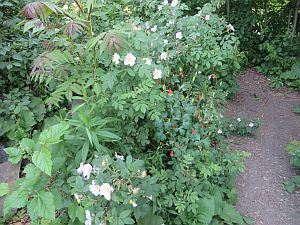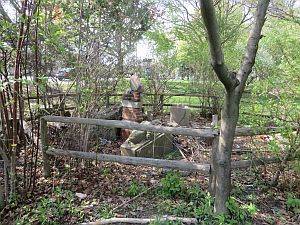
Pages in this Folder:

Related Folders:
See also Department Site Map

This Gardens subsite developed with the kind assistance of the Toronto Parks and Trees Foundation
Comments?
For the basics, see
- Website & Privacy Policies
- How To Get Involved
- The Role of the Park
Search options:
Department Site Map
Custodians:
Dufferin Grove trees, spring and summer 2018
(see also: gardens and trees history}
During the first half of the 1990's there was very little tree planting done by the city, so most new trees from that time were planted by park friends from the neighbourhood. Since 2004, city Forestry staff have planted many new trees in the park, including a dozen or so memorial trees, with community plantings continuing until 2015 as well.
Sand garden (near bigger bake oven)
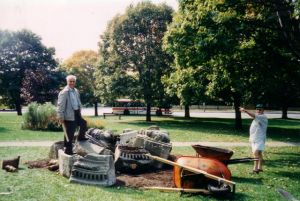
history: constructing the sand garden, 1996
Park friend Gene Threndyle made this garden. He bought the stones and the plants with a Canada Trust Friends of the Environment that we got in 1995. He also got donated stone faces and friezes from a downtown demolition of an old building.
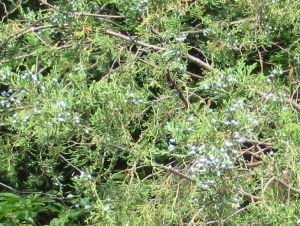
juniper berries in sand garden, July 2018
Eastern Red Cedar is actually a type of juniper, which is why it has the juniper berries.
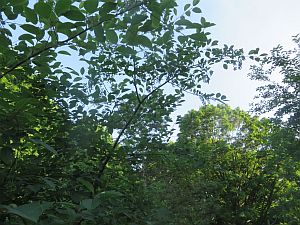
chokecherries in sand garden, June 2018
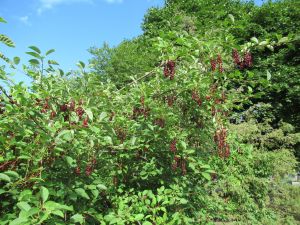
chokecherries July
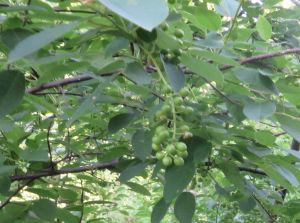
chokecherries June
west side of park along Dufferin Street (Forestry plantings)
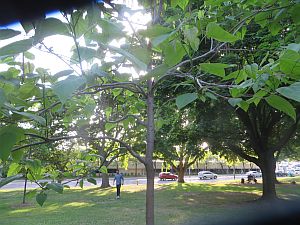
Kentucky coffee tree northwest by market
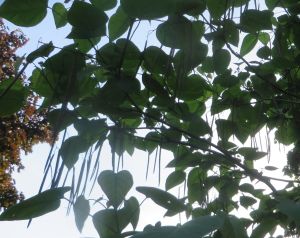
Kentucky coffee tree, pods
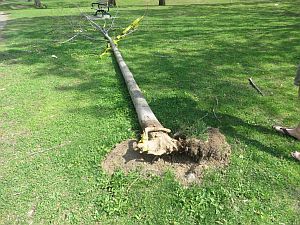
Tulip tree uprooted near market path May 2018
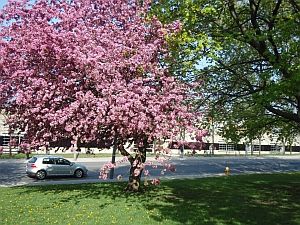
Ornamental crabapple along Dufferin street
Dufferin Street hollow (Community plantings)
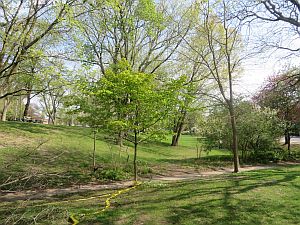
sugar maple and hackberry, May
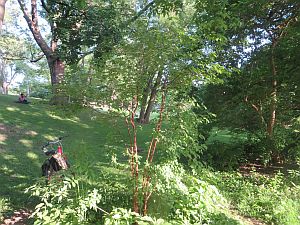
memorial Paperbark Maple - Acer griseum
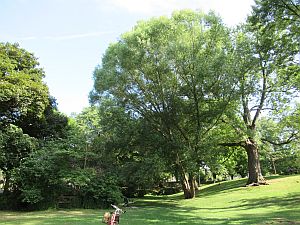
swamp willow
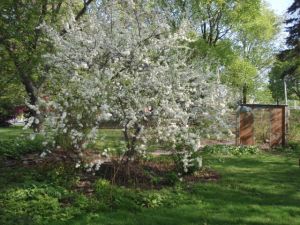
wild plum along path, 2009
Marsh Fountain
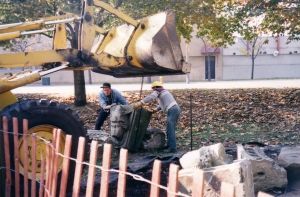
History: city crew installing marsh ruins, 1998
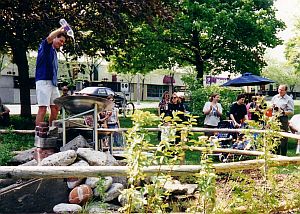
History: Gene Threndyle, opening ceremony 1998
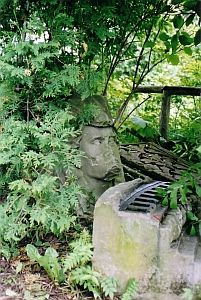
History: Marsh fountain ruins 2009
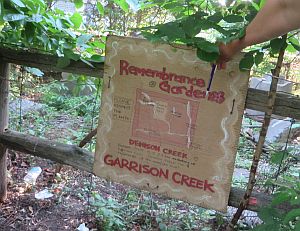
marsh garden sign
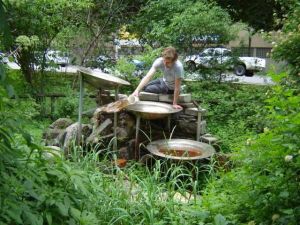
cleaning of bowls
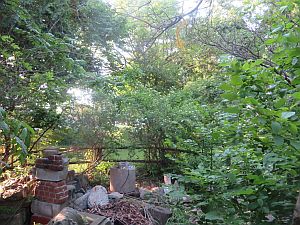
marsh fountain no longer works
Little forests, along Dufferin St. (Forestry plantings)
In the past 15 years, city staff have planted many new trees in the park, including the two “little forests” beside Dufferin Street. Those trees are doing really well and will provide some much-needed shade for the new DOLA (dogs off leash area) planned for that part of the park. There are numerous test spots near the “little forests,” where holes were dug and then filled in, presumably by the consultant whom the city has hired to design the dog park (installation scheduled in 2019).
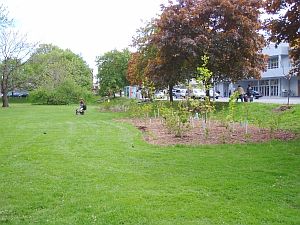
History: little forests planted by Forestry, May 2008
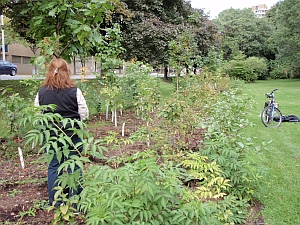
History: Lily weeding little forest, Oct.2008
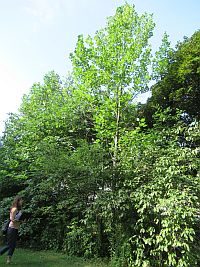
ten years later: tulip tree in little forest, 2018
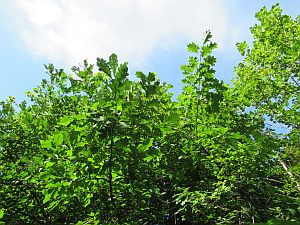
tops of oak trees in little forest, tall and healthy, 2018
- tulip trees like damp -- they're in the right place - white pines gone (can't take the road salt) - oaks doing well but at least one is crowding other trees, should be removed - nasty amount of goutweed
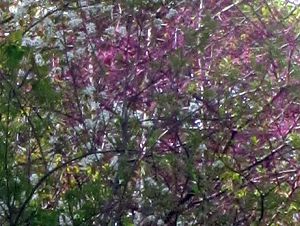
redbud and serviceberry blooms in little forest, May 2018
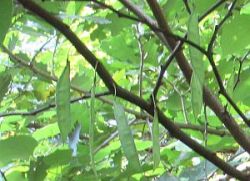
redbud pods in summer
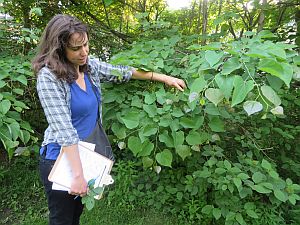
redbud leaves have a beautiful heart shape
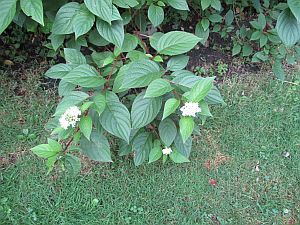
dogwood flowers in little forest, July 2018
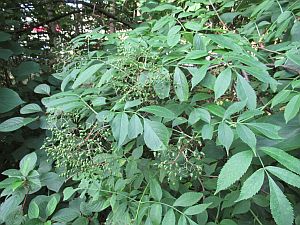
unripe elderberries in little forest, July 2018
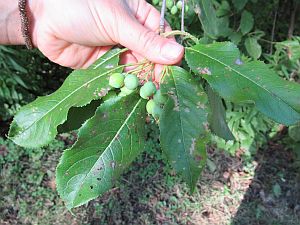
hazelnuts in little forest, July 2018
South part of park (both community and forestry plantings)
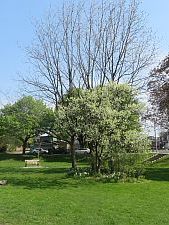
Black walnuts and wild plum May
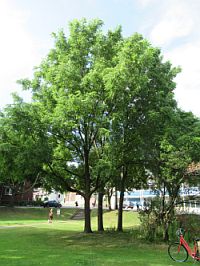
Black walnuts, July 2018
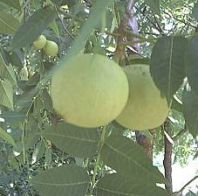
Black walnuts, detail
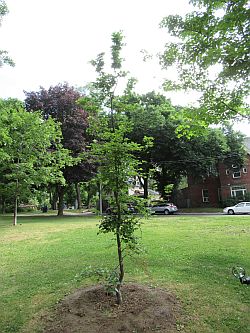
new little beech along Sylvan
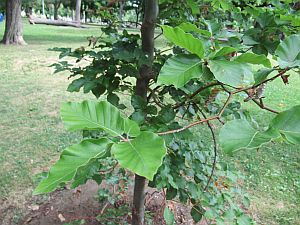
detail of beech leaves
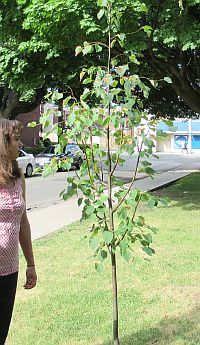
sawtooth poplar along Sylvan
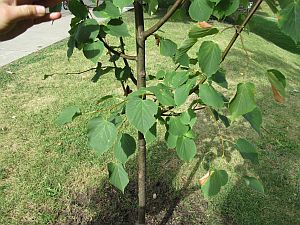
sawtooth poplar
cob gardens (community plantings)
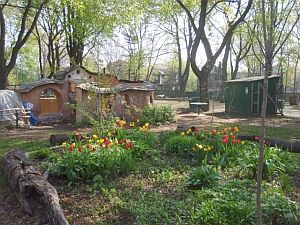
History: cob garden 2009
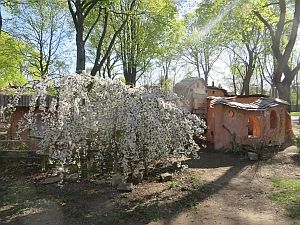
History: cob memorial cherry, May 2015
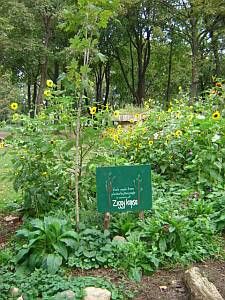
history: memorial black maple for Ziggy, 2006
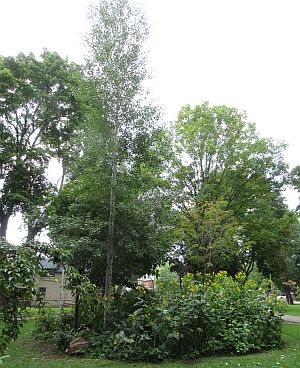
aspen in cob garden, black maple behind
East side of park (forestry plantings)
Dawn redwood:
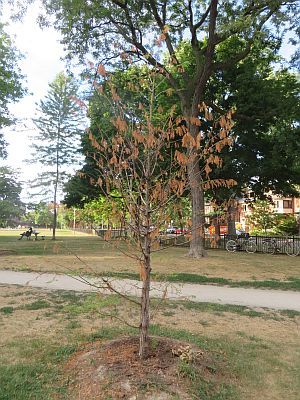
Dawn redwood appears to be dead Aug.12, 2016
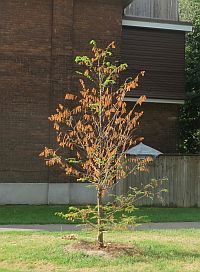
Redwood showing signs of life, Aug.15, 2016
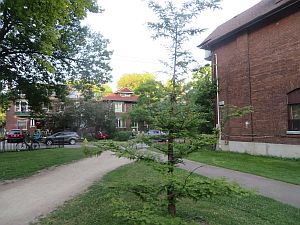
Dawn Redwood looking pretty good
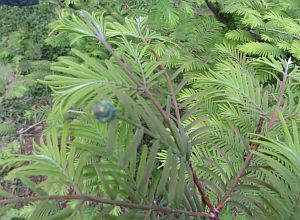
Dawn Redwood: close-up
Dawn redwood, from Canadian Tree Tours:
Dawn redwood is one of the few conifers that are deciduous, dropping their needles every year. Its opposite branching pattern is also unique among the conifers.
The genus name, Metasequoia, is from the Greek work meta, meaning together or near, and sequoia, the name of a closely related North American conifer. The species name, glyptostroboides, means resembling Glyptostrobus, a related genus of conifers.
Distribution: The genus Metasequoia was originally described in 1941 from fossil material; at the time it was thought that all the species in the genus were extinct. However, shortly after, a small population of living trees was discovered by scientists in a remote region of China and by 1948, dawn redwood seeds had been distributed to botanical gardens throughout Europe, North America, and Asia. Today, dawn redwood is widely cultivated.
Dawn redwood is the last known living species of Metasequoia, and is therefore called a living fossil. It is critically endangered in the wild due to deforestation and development in its natural range. Today, very large specimens, thought to be at least 400 years old, are protected, but natural regeneration in the wild is poor.
Black Locust
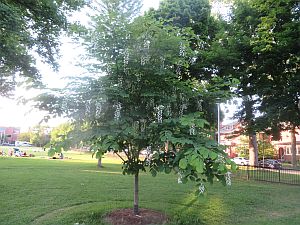
Black locust, east side of park, north of playground
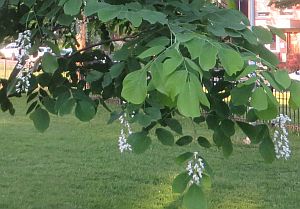
Black Locust flowers: close-up
From Canadian Tree Tours:
Black locust has been mistakenly planted as a native tree. It is found in parks, ravines and forest edges throughout the city and spreads aggressively in areas where mowing has been discontinued.
Black locust is a fast-growing medium-sized tree....It requires sunny sites and does not tolerate shade. The fragrant flowers are eye-catching and increase urban biodiversity by attracting insects. Many cultivars are available.
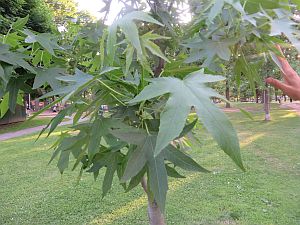
detail: unusual shape of maple leaf?
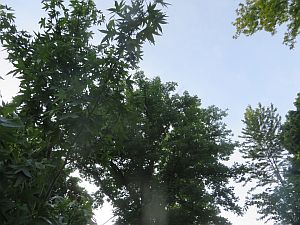
a maple along east side?
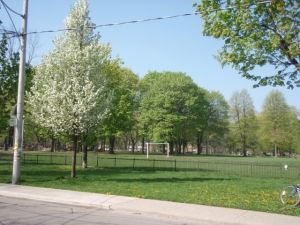
ornamental flowering tree, Havelock Street side
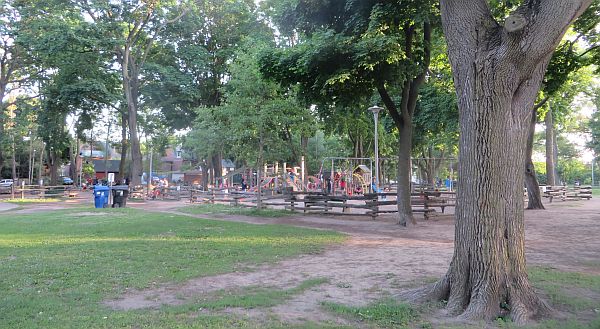
Playground oak (centre, by fence) is doing very well, and lots of shade from Norway maples
park centre (community and forestry plantings)
In 1997, the city put in some white pines and oaks (one of the pines was ceremonially planted by then-Lieutenant Governor Hilary Weston). Soon after, a Canada Trust (now TD) Friends of the Environment grant allowed more plantings, including some around the new pines and oaks, to create a more forest-like habitat. A temporary fence was put around the area, to protect the young trees from dogs. But one pine was left outside the enclosure, and it became a destination for pit bull owners, who encouraged their dogs to jump up on it – putting deep scratches into the tree trunk at the same time. Strangely, this white pine is now taller and it looks fine – who knows why?
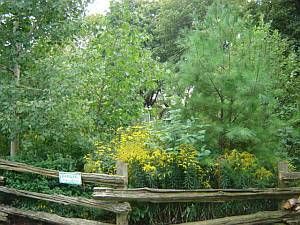
history: protected tree nursery, 2006
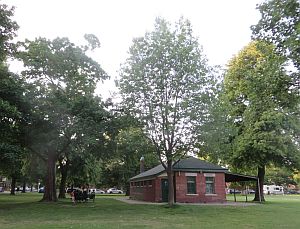
left: maple (1900), centre: oak (1997), right: linden (1952)
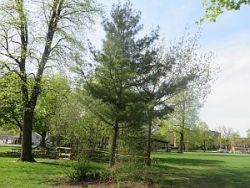
unprotected white pine doing fine
- one aspen was lost in windstorm, others doing fine - oaks doing fine - of the three white pines, the stand-alone one is doing the best -- good that it's protected with the dogwood planted around it.
North by the rink house (community plantings)
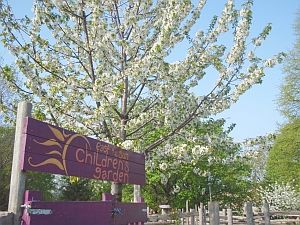
Bigger Bing cherry 2009 (planted 1997)
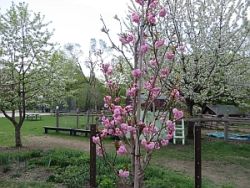
three cherry trees
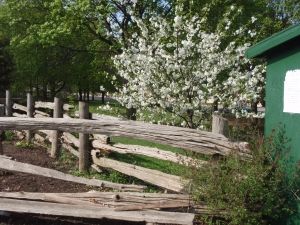
sour cherry near rink house, 2009
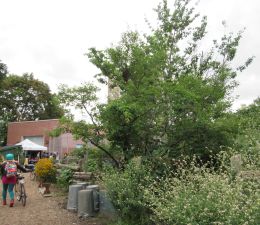
Serviceberry bush, run over three times by zamboni
Park tree care
Compaction hurts trees
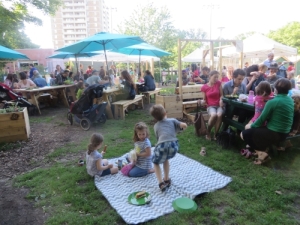
heavy use compacts the ground
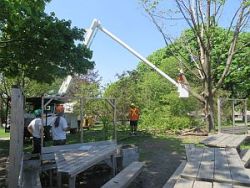
sugar maple was dying, storm finished it
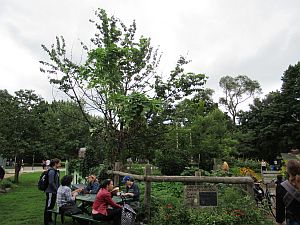
oldest cherry tree is dying
Tree watering
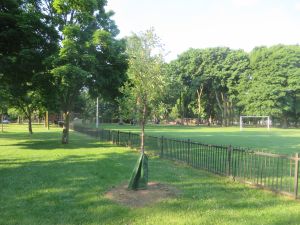
unused tree watering bags all over the park
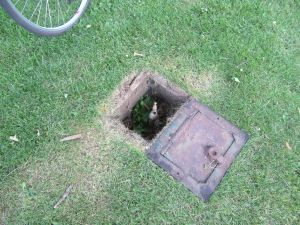
unused watering outlet -- there are more of these
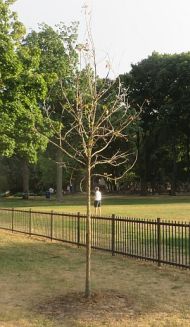
tree in trouble, 2016
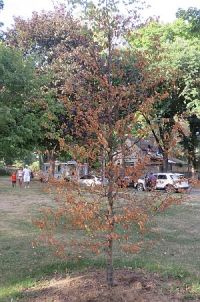
tree in trouble, 2016
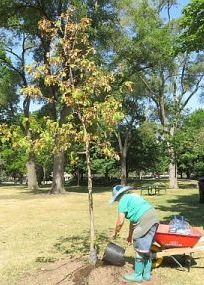
staff watering in 2016 drought
Volunteer watering in the 2007 drought saved 100% of newly planted trees. Staff watering was limited in 2016, and some young trees died.
Fence upkeep or removal
The marsh fountain fence is wrecked, needs to be taken down. Gene Threndyle says the fountain will never work right, should be replaced with a bench.
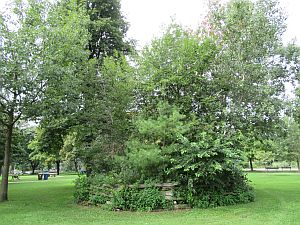
time to remove fence
Park program staff and CELOS asked, in 2016, for the fence around the tree nursery to come down, since the trees are all doing well now, and litter sometimes accumulates inside the fence. No response yet.
Fallen trees as park furniture, or firewood
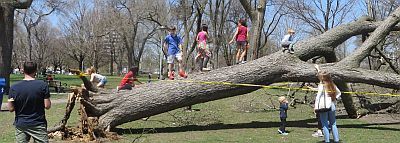
downed tree west of cob, May 6, 2018
Two giant trees, both silver maples, came down in two separate storms in late spring 2018, but many young trees are thriving and ready to replace the missing tree canopy. The two giant tree trunks have been left lying in the park and are having a second career as very popular sitting places and play places for kids.
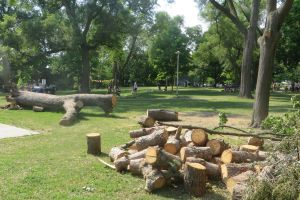
city removed this wood from the park

local firewood gleaning
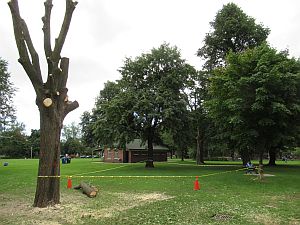
huge area taped for danger -- why?
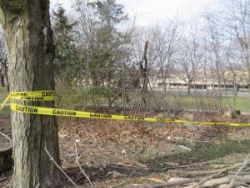
small branch down -- danger tape for three weeks
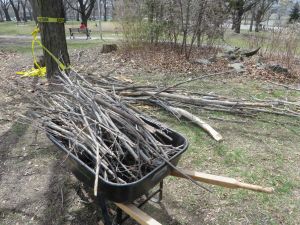
remove danger tape, glean wood for ovens
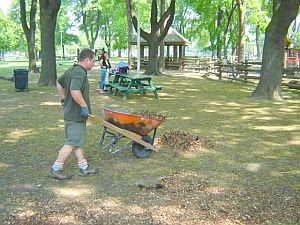
use park wood chips for mulching
Pages for printer


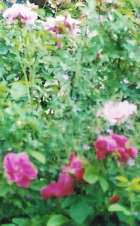

 Printer friendly version
Printer friendly version
